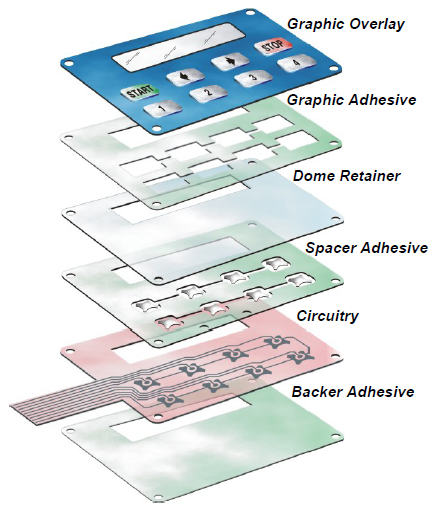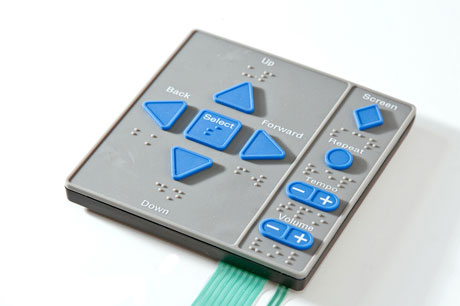Recognizing the Value of Membrane Switches in User User Interfaces
Membrane buttons are important components in the style of effective customer interfaces, assisting in not only capability but additionally enhancing visual charm and user communication. Their distinct attributes, such as resistance to adjustable layouts and environmental aspects, make them suitable for a varied selection of applications across several industries. As we check out the future fads and various benefits related to Membrane modern technology, it becomes clear that these switches are greater than just elements; they stand for a merging of innovation and functionality. The implications of this innovation on individual experience are worth taking a look at better.
What Are Membrane Switches?

The spacer layer, which has glue properties, permits for the splitting up of the circuit layer from the overlay, making sure that the switch continues to be in a non-activated state till pressed. When pressure is applied to the overlay, it presses the spacer layer, linking the space and completing the circuit in the underlying layer. This layout not just decreases the physical space needed for conventional mechanical switches but also boosts the toughness of the device, as Membrane switches are generally immune to dust, dampness, and various other environmental factors.
Generally discovered in applications ranging from customer electronics to clinical tools, Membrane buttons are important to modern technology, offering a user-friendly and efficient user interface that lines up with modern style needs.
Advantages of Membrane Switches
While countless switch modern technologies exist, Membrane Switches offer distinctive advantages that make them especially preferable in various applications. Among the primary benefits of Membrane buttons is their compact design, which enables space-saving implementations in gadgets where actual estate is limited. Their thin account not just enhances visual allure but additionally helps with light-weight building and construction.
Another considerable benefit is their resistance to environmental elements. Membrane buttons are typically sealed against wetness, dirt, and contaminants, making them optimal for usage sought after environments, such as medical gadgets and industrial devices. This resilience extends the life-span of the switch, reducing upkeep prices and enhancing dependability.
In addition, Membrane buttons can be tailored to fulfill specific design requirements, integrating special graphics and shades that improve individual communication. Their responsive feedback options can also be tailored to provide a rewarding user experience. Additionally, Membrane switches are cost-effective, particularly in high-volume applications, as they can be produced efficiently.
Applications in Numerous Industries

In the consumer electronic devices market, Membrane buttons prevail in devices such as microwaves, cleaning devices, and remote controls. Their responsive feedback and visual choices boost individual experience while providing a streamlined, modern appearance. Furthermore, auto makers utilize Membrane switches in dashboard controls and infomercial systems, where area is limited, and customer engagement is essential.
Furthermore, the commercial industry leverages Membrane switches in control panels for equipment and tools, enabling instinctive operation in typically severe settings. Their resistance to chemicals and moisture makes sure longevity and dependability in these applications. On the whole, the adaptability of Membrane Switches adds considerably to their prevalent use, making them crucial in various technological domain names.
Layout Considerations for Membrane Buttons

When designing Membrane switches, a number of crucial considerations need to be considered to ensure optimal functionality and individual experience. First of all, the option of products is essential; selecting durable, top quality substrates can enhance the button's longevity and resistance to ecological factors such as wetness and temperature level variations.
Secondly, the design of the graphic overlay need to focus on clearness and simplicity of use. Icons and message have to be readable, and the design should help with intuitive communication (membrane switches). In addition, tactile feedback is essential; including a responsive dome or other mechanisms can boost the individual experience by providing physical verification of activation
One more essential factor is the button's electrical performance. Developers should ensure that the conductive traces are effectively created to reduce resistance and stay clear of signal disturbance. This continue reading this involves analyzing the required actuation pressure and making sure compatibility with the electronic parts they will user interface with.

Future Patterns in Membrane Technology
As innovation continues to development, Membrane switches are positioned to develop dramatically, driven by developments in products and manufacturing methods. One arising trend is the consolidation of advanced materials, such as versatile substratums and conductive inks, which enhance sturdiness and minimize the overall weight of Membrane switches. These products not just improve the tactile action yet also permit the layout of buttons that can withstand harsher environmental problems.
In addition, the assimilation of touch-sensitive technologies is transforming standard Membrane Switches right sites into even more interactive user interfaces. Capacitive touch sensors embedded within Membrane switch panels can supply an extra receptive and instinctive individual experience, lining up with the expanding need for smooth, modern-day layouts in customer electronic devices.
In addition, advancements in printing techniques, such as digital and 3D printing, enable rapid prototyping and customization of Membrane switches. This flexibility enables makers to respond quicker to market Get More Information demands and consumer preferences.
Lastly, sustainability is becoming a significant emphasis, with makers exploring environment-friendly materials and processes. As these fads unravel, the future of Membrane innovation promises enhanced capability, visual charm, and environmental responsibility, strengthening their duty in sophisticated interface across various sectors.
Verdict
Finally, Membrane Switches stand for a crucial component in the design of interface, integrating functionality with visual versatility. Their advantages, consisting of toughness and resistance to environmental factors, make them ideal for varied applications across numerous markets. Thoughtful layout considerations boost individual interaction and experience. As improvements in technology proceed, the development of Membrane switches is anticipated to further improve individual interfaces, driving technology and enhancing usability in a progressively complex technical landscape.
Membrane buttons are indispensable elements in the layout of efficient user interfaces, promoting not just functionality but also enhancing aesthetic allure and user interaction.Membrane Switches offer as an essential component in different individual interfaces, promoting a seamless interaction between users and electronic gadgets.While many button modern technologies exist, Membrane Switches deal distinct advantages that make them particularly desirable in different applications.Additionally, Membrane switches can be personalized to satisfy specific design requirements, incorporating distinct graphics and colors that improve individual interaction.In final thought, Membrane Switches represent a vital component in the design of user interfaces, combining capability with visual versatility.
Comments on “Exploring the Future of Membrane Switches in Emerging Technologies”